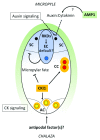Recent advances in understanding female gametophyte development
- PMID: 29983913
- PMCID: PMC6013762
- DOI: 10.12688/f1000research.14508.1
Recent advances in understanding female gametophyte development
Abstract
The haploid female gametophyte (embryo sac) is an essential reproductive unit of flowering plants, usually comprising four specialized cell types, including the female gametes (egg cell and central cell). The differentiation of these cells relies on spatial signals which pattern the gametophyte along a proximal-distal axis, but the molecular and genetic mechanisms by which cell identities are determined in the embryo sac have long been a mystery. Recent identification of key genes for cell fate specification and their relationship to hormonal signaling pathways that act on positional cues has provided new insights into these processes. A model for differentiation can be devised with egg cell fate as a default state of the female gametophyte and with other cell types specified by the action of spatially regulated factors. Cell-to-cell communication within the gametophyte is also important for maintaining cell identity as well as facilitating fertilization of the female gametes by the male gametes (sperm cells).
Keywords: embryo sac; female gametophyte.
Conflict of interest statement
No competing interests were disclosed.No competing interests were disclosed.No competing interests were disclosed.
Figures


References
-
- Maeda E, Miyake H: Ultrastructure of Antipodal Cells of Rice (Oryza sativa) before Anthesis with Special Reference to Concentric Configuration of Endoplasmic Reticula. Jpn J Crop Sci. 1997;66(3):488–96. 10.1626/jcs.66.488 - DOI
-
- Christensen CA, King EJ, Jordan JR, et al. : Megagametogenesis in Arabidopsis wild type and the Gf mutant. Sex Plant Reprod. 1997;10(1):49–64. 10.1007/s004970050067 - DOI
Publication types
LinkOut - more resources
Full Text Sources
Other Literature Sources

